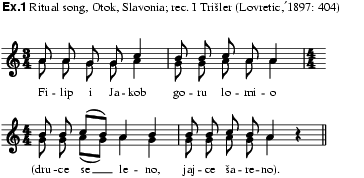
Country in south-east Europe. Once the ancient Roman province of Illyricum, it was settled at the beginning of the 7th century by Slavs, who were converted to western Christianity by the end of the 8th century. Medieval principalities were quickly formed, and a kingdom of Croatia existed from 925 (the dynasty of Trpimirović) to the end of the 11th century. In 1102 Croatia entered into a personal royal union with Hungary; in 1527 it became part of the Habsburg Empire by electing Ferdinand King of Croatia. This political, cultural and social union with Hungary and Austria lasted until 1918. Between 1409 and 1797, however, the Croatian maritime provinces of Istria and Dalmatia were under Venetian control, and from 1526 to 1699 other parts (e.g. the continental province of Slavonia) were conquered by the Ottoman Empire. The region comprising the Republic of Dubrovnik claimed autonomy until 1808. During 1918–41 and 1945–91 Croatia consecutively was made part of the Kingdom of the Serbs, Croats and Slovenes, the Kingdom of Yugoslavia, and the Socialist Federal Republic of Yugoslavia. There was strong German and Italian influence from 1941 to 1945. Since 1991 the Republic of Croatia has been an independent state.
STANISLAV TUKSAR (I), GROZDANA MAROŠEVIĆ (II)
The earliest sources are in the form of Gregorian chant. Several hundred neumed codices and fragments, dating from the 11th century to the 15th, exist in archives and libraries within Croatia (Dubrovnik, Split, Trogir, Sibenik, Zagreb) and beyond (Oxford, the Vatican, Berlin). Some originated in domestic scriptoria (Osor, Zadar, Split, Dubrovnik); others were imported from Italy, Austria, France or Hungary. Numerous illustrations from the 11th century onwards show musical instruments and scenes of music-making along western European iconographical lines. The first performers to be named are the 13th-century ‘kitharists’ Andrija and Cestivoj, who were in the service of a Croatian noble; the earliest composers may probably be placed in the next century (e.g. Augustin Kazotić, bishop of Zagreb). During this period organs were erected in Zadar (13th century), Zagreb (by 1359) and Dubrovnik (1384). The Rector’s Chapel in Dubrovnik, founded in 1301, was active until the fall of the Republic of Dubrovnik in 1808.
In the 16th century 80% of Croatian territory was lost to the Ottomans and the rest divided between Habsburg and Venetian administrations. Music suffered. All the Croatian composers known to us were active abroad, and their compositions and theoretical writings were published abroad, though they probably also wrote and performed at home. The earliest of these composers were Franjo Bosanac (Franciscus Bossinensis) and Andrija Motovunjanin (Andrea Antico da Montona), who composed frottole and ricercari in Venice in the early 16th century and were also engaged in music printing. Their successors included Andrija Petris (Andrea Patritio) from the northern Adriatic island of Cres and Julije Skjatević (Giulio Schiavetti) from Sibenik, responsible respectively for madrigals (Venice, 1550) and greghesche, madrigals and motets (Venice, 1564–5). Henrik and Lambert Courtois published in 1580 madrigals dedicated to members of the Ragusan noble families of Bunić (Bona), Gundulić (Gondola) and Baziljević (Baseglio).
The works of the above composers constitute the entire known corpus of Croatian Renaissance music: the presumably rich repertory of Dubrovnik, known to have been produced by such composers as Secundo Brugnoli, Gavro Temparicić (Tamparizza), Benedikt Babić (Baba), Emanuel Zlatarić, Nikola Gaudencije (Gaudentius) and Antun Tudrović, seems to have been destroyed in the earthquake of 1667. Of other Renaissance material, the first notated folktunes survive in Petar Hektorović’s Ribanje i ribarsko prigovaranje (‘Fishing and Fishermen’s Debates’, 1568), and music is considered in the writings of Federik Grisogono-Bartolacić and Luigi Bassano from Zadar, Matija Vlacić Ilirik (Mathias Flacius Illyricus) from Labin, Frane Petris (Franciscus Patritius) from Cres, Nikola Vitov Gucetić (Niccolň Vito di Gozze) and Miho Monaldi from Dubrovnik, and Faust Vrancić (Faustus Verantius) from Sibenik.
Somewhat unexpectedly, the first half of the 17th century was a golden age for Croatian art music. Several hundred compositions in early Baroque style are extant, the most significant composers being the Franciscan Ivan Lukacić of Sibenik (Sacrae cantiones, Venice, 1620) and Vincenz Jelić, also a cleric, from Rijeka (Parnassia militia, Arion primus and Arion secundus, Strasbourg, 1622, 1628). In the multicultural provinces of Dalmatia and Istria, some Italian-born composers were at work, including Gabriello Puliti, Damianus Nembri and, above all, Tomaso Cecchini, who in addition to collections of masses, motets and madrigals (published 1612–35) produced the first Baroque instrumental music in Croatia: sonatas, ritornellos and ballettos. He spent most of his life in Hvar, which appears to have been a strong cultural centre: one of the first theatres in modern Europe, built there in 1612, is still in operation, and the Chapter Library has a violin tablature dated 1625 by Gabriele Pervaneo as well as treatises by Zacconi and Artusi.
The consequences of the country’s division continued to be felt. While the coastal regions displayed features typical of a remote Venetian province, the hinterland was immersed in the Habsburg Counter-Reformation. One result was that until the second half of the 18th century music in northern Croatia consisted of simple pious songs in Croatian dialects, related to both local idioms and international models, and intended to foster Catholic spirituality throughout the population: examples include Atanazije Grgicević-Georgiceo’s Pisni za najpoglavitije … dni godisća (‘Songs for the Most Important … Days of the Year’, 1635), Nikola Krajacević-Sartorius’s Molitvene knjizice (‘The Prayer Books’, 1640) and the anonymous Pauline songbook (1644). There is also evidence of music at the new Jesuit colleges in Zagreb, Varazdin, Pozega, Rijeka, Dubrovnik and elsewhere, but the revival of the art among the nobility, gentry and urban middle class had to await the withdrawal of the Ottomans (1680–1730) and the subsequent economic recovery.
Music theory was apparently of less concern that it had been in the 16th century, but some treatises survive, including the Asserta musicalia (1656) of the pan-Slavonic visionary Juraj Krizanić (Crisanius) and Dialogo (1619) of Giorgio Alberti of Split. Gjuro Baglivi, the most famous physician of Dubrovnik, published several texts in the 1690s and 1700s treating the therapeutic properties of music, and Krsto Ivanović of Budva, author of the first printed history of Venetian opera (Minerva al tavolino, Venice, 1681), was almost certainly of Croatian origin. Dictionaries from this period, by Jacobus Micaglia (1651), Juraj Habdelić (1670) and Ivan Belostenec (1670–75), include entries in three Croatian dialects for approximately 1300 musical terms.
Among composers working abroad, Ivan Šibencanin (Giovanni Sebenico), from Šibenik, studied with Legrenzi, worked at the Chapel Royal of Charles II, and had at least three operas staged in Turin and Venice between 1673 and 1692: L’Atalanta, L’Oppresso sollerato and Leonida in Sparta (all lost).
During the 18th century the centre of musical life gradually shifted to the northern, interior part of the country, though the coastal regions continued to give birth to remarkable composers. From around 1750 to 1820 Croatian musical culture was marked by two features: the activity of several circles of composers in Split, Dubrovnik and Varazdin, and a keen interest in instrumental music, composed mostly by musicians living abroad. In Split, Benedetto Pellizzari, Julije (Giulio) Bajamonti and Ante Alberti were maestri di cappella at the cathedral, and in Varazdin Ivan Werner, Leopold Ebner and occasionally Johann Baptist Vanhal served parish and monastic churches. Composers in Dubrovnik, though, were traditionally closer to secular authorities and so produced more instrumental chamber music than was usual at this time in Croatia; those concerned included Tommaso Resti, Angiolo Maria Frezza, Giuseppe Zaboglio, Juraj Kraljić, Angelo Bonifazi and Juraj Murat. Specially important were several members of the aristocratic Sorkocević (Sorgo) family: in 1754 Luka, then 20, wrote seven fine symphonies; his son Antun, last ambassador of the Republic of Dubrovnik to Paris, composed instrumental music; and Elena di Pozza-Sorgo wrote some early Romantic songs.
Other major figures worked abroad, and included Amando Ivancić, a Pauline monk, who wrote symphonies, divertimentos and trio sonatas as well as church music, the Split nobleman Stjepan (Stephano) N. detto Spadina, author of sonatas, Ivan Jarnović (Giovanni Giornovichi), a famous traveller and violin virtuoso whose works include 17 violin concertos and much chamber music, and Josip Mihovil (Giuseppe Michele) Stratico, first violinist of the Tartini orchestra in Padua, who left more than 60 violin concertos, 30 symphonies and many trio sonatas. Towards the end of the 18th century the Croatian aristocracy, now risen again to relative prosperity and joined by foreign nobility settled in the recently reconquered province of Slavonia, enjoyed a last period of glory. This was reflected musically in the presence at the courts of Patacić, Drasković, Erdödy and Prandau, among others, of such musicians as Michael Haydn, Vanhal and Dittersdorf.
The spirit of the 18th century lasted well into the 19th; solid foundations for concert life and musical education were then laid with the foundation of a Musikverein in each of the cities of Zagreb (1827), Varazdin (1827) and Osijek (1830). The early Romantic era coincided with a national revival, the Illyrian movement (1835–48), though music benefitted less than literature and political thought. Composers of the Illyrian period (Ferdo Wiesner-Livadić, Ivan Padovec, Josip Runjanin, Ferdo Rusan and others) concentrated on patriotic songs, whose aesthetic value is often inversely proportional to their political commitment and success at the time: these composers strove for music based on folksong, but failed because they had insufficient knowedge of folklore and were technically inadequate. More important than any other Illyrian was Vatroslav Lisinski (1819–54), the tragic figure of Croatian Romanticism, who was harrassed throughout his short life by the pro-Habsburg establishment in Zagreb and had no opportunity to develop his exceptional talent – though he did compose the first Croatian opera (Ljubav i zloba, ‘Love and Malice’, staged 1846), besides songs, choral pieces and orchestral music.
During the ensuing creative lull (c1850–70), occasioned by the unfavourable social climate resulting from the post-1848 Habsburg oppression, musical life was restructured. Singing societies were established in Karlovac (Zora, 1858) and Zagreb (Kolo, 1862), and the Zagreb Musikverein came under state support and was Croaticized in 1861 as the Narodni Zemaljski Glazbeni Zavod.
The late Romantic period was dominated by the composer Ivan Zajc (1832–1914) and the musicologist Franjo Ksaver Kuhac (1834–1911). Trained in Italy, Zajc arrived in Zagreb in 1870 after a successful career as an operetta composer in Vienna to become both the first director of the newly founded Croatian National Opera (1870–89) and director of the Glazbeni Zavod music school (1870–1904). He left a large output in all genres, but most important were his many stage works, among which his masterpiece, the opera Nikola Šubić Zrinjski, is an emblem of Croatian patriotism. Other composers of this period – Antun Schwartz, Duro Eisenhuth, Vilko Novak, Antun Vancaš, Vatroslav Kolander – were outshone. Franjo Kuhac, the founder of Croatian musicology and musical historiography, provided a solid basis both for ethnomusicology in the country and for the national style cultivated by composers in the 1920s and 1930s.
The 20th century was an extraordinary period of increasing professionalism and creative diversity, with radical turning points in 1916 and 1961. Compensation for the lack of a mature musical nationalism in the 19th century, and a counterbalance to Zajc’s rather bland internationalism, came in the work of a well trained generation of composers born in the 1870s and 1880s, some inclining to late Romanticism and modernism (Blagoje Bersa, Franjo Dugan, Josip Hatze, Dora Pejacević), some to the use of folklore (Antun Dobronić, Ivan Matetić-Ronjgov). These two streams persisted until the 1960s, represented by such later composers as Fran Lhotka, Krešimir Baranović, Krsto Odak, Bozidar Širola and Jakov Gotovac (folklore idioms) and Josip Štolcer Slavenski, Bozidar Kunc and Ivo Parać (international styles).
After the first Zagreb Biennale for Contemporary Music (1961) came a period of pluralism. Some composers never abandoned tonality (Boris Papandopulo, Ivan Brkanović, Stjepan Šulek, Bruno Bjelinski, Andjelko Klobučar), others began to evolve (Milo Cipra, Natko Devcić, Branimir Sakac), and still others were immediately associated with the radical avant garde (Milko Kelemen, active in Germany, Ivo Malec, working in France, Stanko Horvat, Ruben Radica, Dubravko Detoni, Igor Kuljerić, Davorin Kempf). Younger composers, born between the 1940s and 1960s, were educated within the avant-garde atmosphere and have introduced a postmodern sensibility; they include Silvio Foretić (living in Germany), Marko Ruzdjak, Frano Parać, Berislav Šipuš, Mladen Tarbuk and Srdjan Dedić.
Outstanding performers have included Milka Trnina, Zinka Milanov, Lovro von Matacić, the Italian-born Antonio Janigro, Zlatko Baloković, Dunja Vejzović, Ivo Pogorelich and Radovan Vlatković; among teachers have been Václav Huml, Svetislav Stancić and Rudolf Matz. The country has four opera houses (in Zagreb, Split, Osijek and Rijeka), several symphony and chamber orchestras (notably in Zagreb and Dubrovnik), festivals, choirs, etc. Croatian musicologists since Kuhac have worked on national musical history (Bozidar Širola, Josip Andreis, Lovro Zupanović) and some have received international recognition (Dragan Plamenac, Ivo Supicić).
F.K. Kuhac: Ilirski glasbenici: prilogi za povijest hrvatskoga preporoda [Illyrian musicians: contibutions to the history of the Croatian Renaissance] (Zagreb, 1893/R)
D. Plamenac: ‘Toma Cecchini, kapelnik stolnih crkava u Splitu i Hvaru u prvoj polovini XVII. stoljeća’ [Toma Cecchini, maestro di cappella of Split and Hvar cathedrals during the first half of the 17th century], Rad JAZU, no.262 (1938), 77–125
B. Širola: Hrvatska umjetnička glazba [Croatian art music] (Zagreb, 1942)
K. Kovačević: Hrvatski kompozitori i njihova djela [Croatian composers and their works] (Zagreb, 1960)
Z. Hudovsky: ‘Razvoj muzičke kulture u Zagrebu od XI. do konca XVII. stoljeća’ [The development of musical culture in Zagreb from the 11th century to the end of the 17th], Rad JAZU (1969), 5–62
M. Grgić: ‘Glazbena djelatnost u Hrvatskoj u 11. stoljeću’ [Musical activities in Croatia in the 11th century] Zadarska revija, xix (1970), 125–32
K. Kos: Musikinstrumente im mittelalterlichen Kroatien (Zagreb, 1972)
J. Andreis: Music in Croatia (Zagreb, 1974, enlarged 2/1982)
K. Kos: ‘Geschichte, Stand und Perspektiven der Forschungen zur mittelalterlichen Kirchenmusik in Kroatien’, IRASM, vi (1975), 289–306
S. Tuksar: Hrvatski renesansni teoreticari glazbe [Croatian Renaissance music theorists] (Zagreb, 1978; Eng. trans., 1980)
S. Majer-Bobetko: Estetika glazbe u Hrvatskoj u 19. stoljeću [Aesthetics of music in Croatia in the 19th century] (Zagreb, 1979)
L. Županović: Stoljeća hrvatske glazbe [Centuries of Croatian music] (Zagreb, 1980; Eng. trans., 1984–7)
M. Demović: Glazba i glazbenici u Dubrovačkoj Republici od početka XI. do polovine XVII. stoljeća [Music and musicians in the Republic of Dubrovnik from the beginning of the 11th century until the mid-17th century] (Zagreb,1981)
K. Kos: ‘Style and Sociological Background of Croatian Renaissance’, IRASM, xi (1982), 55–82
L. Šaban: 150 godina Hrvatskog glazbenog zavoda [150 years of the Croatian Music Institute] (Zagreb, 1982) [with Ger. summary]
Glazbeni barok u Hrvatskoj: Osor, Croatia, 1986 [with Eng. summary]
M. Demović: Glazba i glazbenici u Dubrovačkoj Republici od polovine XVII. do prvog desetljeća XIX. stoljeća [Music and musicians in the Republic of Dubrovnik from the mid-17th century until the first decade of the 19th century] (Zagreb, 1989)
E. Stipčević: Hrvatska glazbena kultura 17. stoljeća [Croatian music culture of the 17th century] (Split, 1992)
S. Tuksar: Hrvatska glazbena terminologija u razdoblju baroka [Croatian music terminology in the Baroque period] (Zagreb, 1992)
Croatia, §II: Traditional music
Music-making in traditional communities was, and to a certain extent still is, an integral part of everyday working life. Various songs are performed during labour and rest-periods, and also after work (such as harvesting and hoeing) for entertainment. Outdoors, where people are physically separated by distance, short dialogue songs (the samica, rozgalica, vojkavica) establish communication. Separation also contributed to the development of the songs and music of solitary travellers, and shepherds who play their solo instruments, the dvojnice and tambura (see §2 below), passing the time spent with their livestock at pasture.
Music is also performed during leisure time, at public gatherings, for example, such as the kolo or round-dance socials organized on Sundays and saints' days. Short songs based on 10-syllable couplets (for example the poskočnice) are also sung to express emotions, to convey a particular message and to comment or criticize. The jocular character of these songs allows expression of what is sanctioned in ordinary conversation. Young people participating at public dance parties have the opportunity to observe and choose future spouses, particularly in the biračko kolo (a round-dance).
Young children absorb their first experience of music from lullabies and songs sung to them by their mothers and grandmothers. As well as calming children before sleep, these songs play a role in enculturation. Older children satisfy their need for play, structured movement and musical expression by performing brojalice (counting-rhymes), various games with movement, mimicking games etc.
In the marking of life cycle events, music plays its most important part in wedding customs. In the past, members of the wedding party sang songs that had a ritual function, while during the 20th century they were gradually replaced by musicians. Among customs connected with death are the practice of ringing bells that announce the gender and age of the deceased, and the performance of laments (naricanje). In some regions (Turopolje, Kordun) professional female lamenters were engaged, but it is more usual for laments to be sung by close female relatives. Although not considered music, the performance of laments has poetic and musical elements.
Music-making is an integral part of calendar rituals, performed by organized groups in processions at Christmas and New Year, Carnival, or on saints' days etc. They go from door to door performing songs expressing good wishes to the households. The tunes and their sometimes strictly set performing styles were believed to have magical powers. For example, Carnival dances with foot-stamping and high leaps were thought to enhance the turnip and flax crops. Socializing and entertainment of the participants in the calendar rituals are additional motives for taking part, and they could also count on considerable material gain. These rituals occasionally survive today as expressions of local cultural identity.
The use of signalling and noise-making instruments – bells, trumpets, rattles, whistles and drums – is connected with door-to-door rounds. They mark the beginning and end of the rituals, and mark the separate identities of the performers. Previously such instruments had other purposes, such as bellringing and mortar-firing to drive away hail-bearing clouds, while a system of klepala (wooden clappers) at military outposts alerted the community to danger. In northern Croatia heralds can still be found who beat old Austrian military drums to announce news. However, today noise-making instruments are more often used by sports fans and Zagreb high school students on their last day of school.
Elements of traditional secular music are found in Roman Catholic liturgical and paraliturgical singing in Croatia, particularly in Glagolitic singing which has been transmitted by oral tradition (see Glagolitic Mass, Glagolitic chant). Lay singing in church is often led by the more gifted singers, giving them high standing in their communities. On special occasions, such as festivals and celebrations, traditional bellringing (kampananje, trnačenje) takes place.
There is much less historical data available on music-making by the aristocracy and the bourgeoisie. From the end of the 17th century there have been wine-drinking societies which come together on St Martin's Day (when the must is baptized) and on New Year's Eve. Napitnice (drinking songs) are a typical genre connected with their social gatherings.
Because of the greater role of broadcasting and recorded Media in musical culture, people today usually listen to music rather than make it. Spontaneous music-making is much less a part of everyday working life but is practised at private parties, birthday celebrations, weddings, on excursions and other gatherings.
The presentation of music outside of its traditional context arose particularly at the time of the national movements during the 19th century, and it was widespread during the 20th century. From the 1920s, folklore festivals began to emerge. They were first organized by the Seljačka Sloga (Peasant Unity), the cultural branch of the Croatian Peasants Party, the strongest political party during the 1930s. Its platform raised national self-awareness as a form of resistance to centralizing pressures within Yugoslavia, of which Croatia was a part. Folklore festivals largely follow the concept of presenting local folklore tradition without much adaptation. Music is only part of the total programme, in which dance predominates. There are some 70 festivals, the main one held in Zagreb during the summer (since 1966 as the International Folklore Festival). There are around 600 amateur folklore groups, found mainly in rural areas. Urban groups were founded after 1945 and they perform choreographed dances of various Croatian regions. The only professional folkdance and music ensemble is the Lado, established in 1949. Croatian Radio also has its own Tambura Orchestra, established in 1941. Festivals devoted to traditional music and not to dance are a rarity, one being the Dalmatian Klapa Festival held in Omiš since 1967.
Arranged traditional music was performed during the 1960s and 70s, mostly by pop and opera singers; since the 1980s there have been isolated attempts at jazz and rock fusions; while throughout the 1990s many traditional tunes have been reinterpreted in styles related to trends in world music.
Recording companies show modest interest in traditional music (about 10% of output, usually in adapted form, with a smaller amount of field recordings). Neo-traditional music is given more attention (about 20% of output). There is a similar degree of representation on TV programmes (about 90 minutes per week on state TV); while it is much higher on radio programmes (some 27 and a half hours per week on state radio stations).
During the 1960s, the appearance of popular music festivals was accompanied by the rise of regional song festivals in which certain traditional elements were used in popular music styles. Many of these songs have been absorbed into regional repertories primarily due to their texts (dialect and vocabulary) and the use of traditional instruments like the tambura. They are performed by pop singers with orchestral accompaniment, and their popularity is usually limited to a particular region. Amateur groups perform at the Omiš festival and also sing compositions closer to the traditional models.
From the 1960s to the 90s, so-called ‘newly composed folk songs’ produced mostly in the eastern parts of Yugoslavia also had an audience and were produced in Croatia. Although there had been previous resistance to these songs, it became much stronger after the war with Serbia in 1991, when they were identified with the enemy. Since then ‘neo-traditional’ songs with a tambura ensemble accompaniment have been booming in Croatia. Tambura music has been promoted as a symbol of national musical identity. There has also been a strengthening of popular music in regional idioms.
‘Neo-traditional’ music is only part of popular music culture in Croatia, which is dominated by other international and domestic genres.
Croatia, §II: Traditional music
The profusion and variety of styles existing in traditional music in Croatia are the result of the overlapping of different cultures: central-European (Pannonian and sub-Alpine), Mediterranean and Balkan.
In Pannonian areas (Slavonija, Baranja and Srijem) diatonic two-part singing, with four- to six-note melodic groupings, is found. The upper leading part, delivered by a soloist, ends mostly on the second degree, while the accompanying part, sung by a group, concludes in unison (in the older tradition; ex.1), or a perfect 5th below the upper part (in the newer tradition; ex.2). Sometimes, when the group of singers is larger, the lead voice is obscured by the accompanying voices. Part-singing usually comprises a drone (in older tunes) or remnants of a drone combined with parallel movement (mostly in 3rds). In the 20th century the newer style – na bas singing – has been widespread throughout various Croatian regions, but is most common in eastern parts, where it originated in the late 19th century. Apart from lyrical and ballad songs with longer texts, short songs are also found (based on 10-syllable couplets and known as svatovac, bećarac and poskočica).
Until the beginning of the 20th century the gajde (bagpipe), a single-reed instrument with double chanter and a drone pipe fixed to a bellows, and the dude (bagpipe with triple chanter, found in western Slavonia) were the main instruments which accompanied dance. They were superseded by tambura ensembles. The tambura, a long-necked lute, was brought to the Balkans by the Turks in the 14th and 15th centuries. Through migrations caused by Ottoman incursions, the tambura was brought to Slavonian areas in the 17th and 18th centuries, where it was gradually adopted. At first it was a solo instrument (samica), but from the mid-19th century tamburas were also brought together in small groups. Today tamburas are widespread throughout Croatia, existing in various shapes, with varying number of strings (usually four), and in various tunings. The present standard combination of the tambura ensemble includes: two bisernica (small instruments which play the melody), two brač (for melodic and harmonic parts), a bugarija (of medium size for accompaniment in chords), and the berde (the largest and lowest in pitch for the bass line).
In eastern Croatia many dances, often in the form of closed circle (kolo or round-dances), are accompanied by singing. Today most of them are also accompanied by tambura ensembles. The most famous kolo dance, known as Šokačko kolo, Slavonsko kolo or simply the Kolo, has become a symbol of the identity of the people of eastern Croatia. The music and dancing is interrupted by the dancers who sing couplets improvised on the spot.

![]()
The Medimurje and upper Podravina regions have unison tunes with melodies of a wider range, often based on medieval modes (especially the Dorian, ex.3, Aeolian and Phrygian modes) and anhemitonic pentatonic scales (ex.4). They are frequently in mixed and asymmetrical metres with unequal bar units, or are developed in free (parlando-rubato) rhythm. Lyrical texts (often concerning love) are performed to these tunes. Typical instruments are: the dude or mrčaljka (bagpipes; no longer played), the citura in Podravina or the trontolje in Medimurje (bourdon box zithers), and the cimbal (dulcimer) which came from Hungary and is played as a solo instrument or in mixed bands. Violins are common in instrumental groups, joined by the cimbal and tambura as accompaniment. There are also the bandisti (brass bands) which play at socials and weddings. Tambura bands emerged during the 20th century, particularly among amateur folklore groups.
Dancing in formation of open or closed circles (the kolo dance), accompanied by singing (often ballads) began to disappear at the end of the 19th century when several couple-dances were introduced from the neighbouring north-west, for example the čardaš, polka, valcer and zibnšrit. There are also solo dances, e.g. the moldovan stick-dance, performed by skilful male dancers.
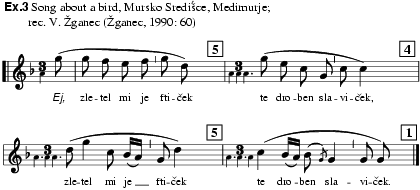
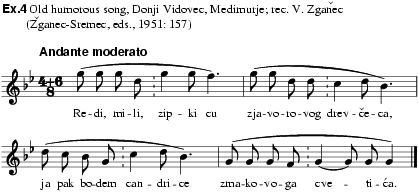
This comprises Croatian Zagorje, the broad surroundings of Zagreb, and the Žumberak, Pokuplje, Upper Posavina, Moslavina and Bilogora regions. Diatonic tunes with four- to six-note melodic groupings are common in these regions, sometimes with changeable degrees (e.g. between a major and minor 3rd above the lowest tone; ex.5). Usually melodies conclude on the second ‘degree’ which can also be the ‘tonic’. Apart from unison tunes (mainly in ritual songs), there are two-part songs with unison-endings (an older tradition), or in the interval of the major 3rd and perfect 5th (a newer tradition). Newer repertory includes tunes which tend to or are already in a major mode (ex.6).
There are various flutes: the žvegla or the frula (duct flute), the dvojnice or dvojke (double duct flute) and others made as souvenirs and toy instruments in the shapes of birds, fish, hammers or walking-sticks. In the 19th century and beginning of the 20th, dances were accompanied by the dude (a bagpipe with triple chanter) in the Bilogora and Moslavina areas. The guci instrumental groups, consisting of two gusle (violins) and the bajs (a doublebass played with a bow), sometimes together with a cimbal (dulcimer), were found across the whole region. In the first half of the 20th century they were joined and/or replaced by various kinds of tambura, which spread from eastern Croatia (Slavonia).
In dance repertories the drmeš dance is widespread. It is danced in couples or in small circular groups, and has two basic figures: in the first, small steps are made with marked shaking of the entire body; in the second, the circular group whirls at fast tempo. Along with the drmeš, the polka is the most popular dance of these regions.
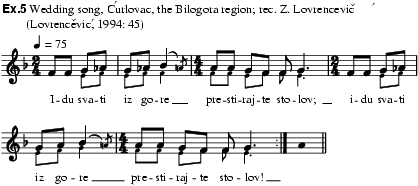
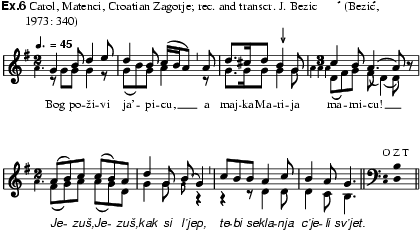
Consisting of the northern Adriatic areas (the Istrian Peninsula, the Quarner Bay and its islands such as Krk, Cres, Lošinj and Susak), western Croatia's traditional music is characterized mainly by chromatic modes with successive (approximate) semitones, or with an (approximate) whole tone alternating with semitones. Two-part singing in pairs (of the same or mixed gender) is performed with movement in parallel (approximate) minor 3rds, with a delayed unison ending, arrived at by contrary motion (ex.7). The inversions of these intervals (approximate major 6ths and octaves) appear when the accompaniment is in the upper part (for example when the leading part is performed by a male singer). The singers often insert vocables at the end of particular words, or between the syllables, for example ‘ma’, ‘nina nena’, ‘trajna naj’ etc. Sometimes the entire refrain is performed in this way, or even the entire tune, which is customary when there is no instrumental accompaniment to the dance. This style of singing is called tarankanje.
Dances are frequently accompanied by two sopila or roženica, large and small double-reed wind instruments, which produce two-part music with similar characteristics to those in singing. On solemn festive occasions, the mantinjada is played on them (ex.8). It is also customary to dance to a šurle accompaniment (single-reed instrument with two separate chanters), to the mih or meh (the same as the diple na mješinu), and in the inland northern part of Istria, to an instrumental group called gunjci (a violin, clarinet and a two-string doublebass), and, more recently, to the (h)armonika (a diatonic accordion).
This region is characterized by the tanac and the balun dances. They have several figures performed by the dancers facing in two rows and as couples regularly distributed in a circle, figures in which very small steps are made and those in which the female dancers spin very quickly. Other dances, like the polka and the valcer, are also performed.
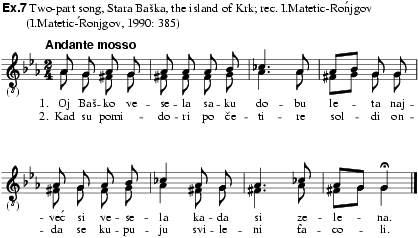
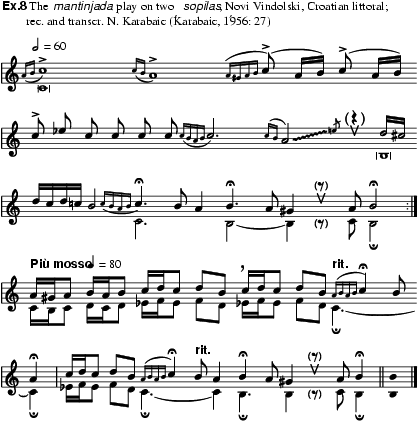
The older tradition of the Dalmatian hinterland and the Lika region is characterized by narrow-interval style: tunes are based on chromatic modes of narrow range, with intervals that deviate from the tempered system. In two-part singing drone accompaniments and intervals of the 2nd frequently appear. The parts also finish on the interval of a 2nd (ex.9). Short songs (decasyllabic couplets) are performed in a peculiar style of singing, usually known as ojkanje. It is characterized by performing melisma of varying lengths, sometimes with sharp and prolonged shaking of the voice on the syllables ‘Oj’, ‘hoj’, ‘voj’, ‘ej’ or ‘aj’ (ex.9). Ojkanje is connected with mountain areas and stock-raising cultures, and is practised outdoors. It appears as the solo singing of lone travellers (putniško), or in two-part tunes (vojkavica, treskavica, rera, ganga, rozgalica). Ojkanje is also known in Bosnia and similar singing styles exist in the mountain regions of Albania, Bulgaria, Greece and Turkey.
Narrative songs (epic and ballad) are performed by individual singers who often direct their gaze at a hand-held book or cap (singing iz kape, iz knjige, ‘from a cap, from a book’) to aid concentration, as the songs are long and sung from memory. The most famous performers of epic songs are guslari, singers who accompany themselves on the gusle, a bowed, single-string chordophone widespread in the Balkans. They perform all the verses improvising two basic recitative melody-sections. The instrumental melody is similar to the vocal one (ex.10). Guslari were highly respected in their community.
The diple is a widely distributed single-reed instrument with a double chanter, the older type of which produces one-part, and the newer, two-part music. Frequently it is attached to a bellows (then called diple na mješinu or mih). This kind of bagpipe does not have a drone-pipe, and is also found all along the Adriatic coast and on the islands. It is played by shepherds, but also at parties, sometimes to dancing.
Newer musics, especially in the Lika region, are charactized by diatonic tunes in the na bas style. The solo-tambura (the danguba) is also found, the musician using it to accompany his own singing.
The nijemo kolo (the mute kolo dance) without any musical accompaniment is common in dance repertories, the rhythm provided by the dance-steps and the sound of the rattling of the ducats adorning the dancers' costumes. It is performed in large steps and jumps in various figures which change to the commands of the dance-leader.
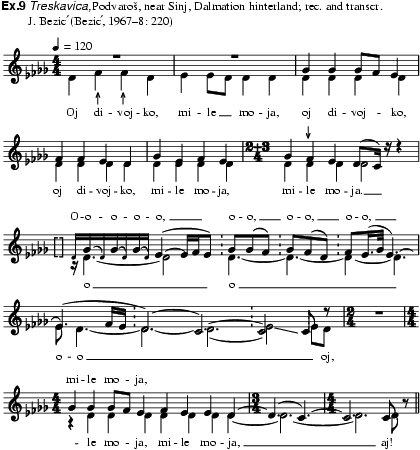

This region comprises coastal Dalmatia and its islands. Older traditions (particularly in northern Dalmatia) are marked mainly by diatonic two-part singing with a small range and delayed unison endings (ex.11); endings in 5ths became common around the mid-20th century. In the very south (around Dubrovnik) single-part singing is more common. Songs of more recent traditions have characteristics of the major mode. A gradual descent from the seventh to the third degree is typical for the upper part of these songs. They are performed as two-part (in parallel 3rds) or multi-part harmonic songs (ex.12). The latter is known as klapsko pjevanje (klapa singing) because it is performed by a male group (called a klapa), made up of between four and eight singers. In the mid-19th century it was performed in urban centres, and during the 20th century it was introduced into villages. Wide popularization of klapa singing is linked to the Dalmatian Klapa Festival in Omiš (established in 1967), where every year arrangements of traditional klapa songs, as well as new compositions in the style, are performed. During the last two decades this style of singing became strongly identified with Dalmatian music. Popular songs are sometimes performed in this style.

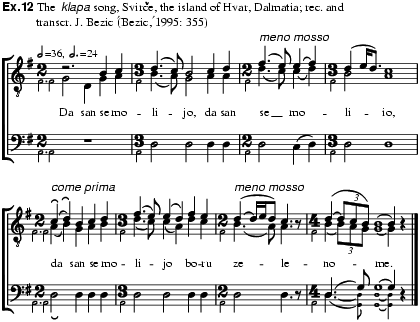
In villages, dances (usually in couples) are accompanied by the mih or mišnjice, and the lira or lijera (lirica or lijerica in its diminutive form) in the southern Adriatic region (see illustration). The lira is usually used to accompany the poskočica (also known as the linđo) dance. In towns mandolin ensembles accompany urban dances, such as the šotić, manfrina, kvadrilja and polka šaltina. On the islands of Korčula and Lastovo the moreška and the moštra (sword dances) are still performed, usually at Carnival time.
Croatia, §II: Traditional music
Although the first notations of traditional music date from as early as the 16th century, indirect sources (for example hymnals with examples of contrafactum, descriptions, travel notes and so on) predominated until the 19th century, when interest grew and traditional music started to be written down. Franjo Ksaver Kuhač (1834–1911) was the founder of Croatian ethnomusicology. He noted down more than 2000 tunes and wrote numerous papers on traditional music. His collection of instruments is kept in the Ethnographic Museum in Zagreb.
Systematic research continued in the 20th century. During the 1920s, the Ethnographic Museum in Zagreb organized phonographic recordings (120 wax rolls kept in the Phonogram-Archiv in Vienna). Notable researchers included Božidar Širola (1889–1956), a composer and musicologist who studied traditional instruments and wrote the first synthesized review of Croatian traditional music; and Vinko Žganec (1890–1976) who noted down more than 15,000 tunes and published them in a number of extensive collections. During the 1950s and 60s, under the auspices of the Institute for Folk Art in Zagreb (established 1948, today the Institute for Ethnology and Folklore Research), Žganec organized research in the individual regions. The focus of interest at that time was the rural music of the earlier traditions and the study of musical structures.
The institute has a specialized library and documentation fund (for manuscripts, photo-, phono- and video-recordings and computerized databases). The ethnomusicologists Stjepan Stepanov (1901–84) and Jerko Bezić (b 1929), and Ivan Ivančan (b 1927) the ethnochoreologist, have made a great contribution to the institute's research projects. Under the influence of contextual folklore studies and anthropology, the subject of research has been considerably broadened since the 1970s and has covered many aspects of traditional and contemporary music and dance culture.
Croatia, §II: Traditional music
and other resources
A Collections. B Studies of special regions. C Instruments. D Dances. E Other studies. F Recordings.
F.K. Kuhač: Južno-slovjenske narodne popievke [Southern Slav folksongs] (Zagreb, 1878–81)
V. Žganec: Hrvatske pučke popijevke iz Medimurja [Croatian folksongs from Medimurje] i: Svjetovne [Secular]; ii: Crkvene [Religious] (Zagreb, 1924–5) [vol. i. incl. introduction on region and music]
V. Bersa: Zbirka narodnih popievaka iz Dalmacije [Collection of folksongs from Dalmatia] (Zagreb, 1944)
V. Žganec: Narodne popijevke Hrvatskog Zagorja [Folksongs of Croatian Zagorje], i: Napjevi [Tunes] (Zagreb, 1950); ii: Tekstovi [Texts] (Zagreb, 1952); iii: ‘Etnomuzilolška studija’ [Ethnomusicological study], Zbornik za narodni život i običaje JAZU, xliv (1971)
V. Žganec and N. Sremec, eds.: Hrvatske narodne pjesme i plesovi [Croatian folksongs and dances] (Zagreb, 1951) [incl. V. Žganec: ‘Osnovni stilovi hrvatskih narodnih pjesama’ [The basic styles of Croatian folk melodies], 5–9; with Eng. trans., 228–31]
N. Karabaić: Muzički folklor hrvatskog primorja i Istre [The musical folklore of the Croatian littoral and Istria] (Rijeka, 1956) [incl. 10 gramophone 78 r.p.m. records]
V. Žganec: Hrvatske narodne popijevke iz Koprivnice i okoline [Croatian folksongs from Koprivnica and its surroundings] (Zagreb, 1962) [with comments and musical analysis]
I. Ivančan: Istarski narodni plesovi [Istrian folkdances] (Zagreb, 1963) [with Eng. summary]
V. Žganec and M. Meršić: Jačkar: hrvatske narodne jačke iz Gradišća [Croatian folksongs from Burgenland (Austria)] (Čakovec, 1964) [with commentary by Žganec]
S. Stepanov: ‘Narodne pjesme iz Gorjana i Potnjana’ [Folksongs from Gorjani and Potnjani in Slavonia], Zbornik za narodni život i običaje južnih Slavena, xliv (1971), 283–422
K. Kljenak and J. Vlahović, eds.: Zbornik dalmatinskih klapskih pjesama [Collection of Dalmation klapa songs], i, (Omiš, 1979) [incl. J. Bezić: ‘The Dalmation klapa songs within the ten years of the Omiš festival’]; ii, ed. N. Buble (Omiš, 1991); iii, ed. N. Buble (Omiš, 1992)
B. Kostelac: Narodni plesovi i pjesme Jaskanskog prigorja i polja [Folkdances and songs from the region around Jaska] (Zagreb, 1987) [with Eng. summary]
G. Knežević: Plešem, plešem drotičko: zbirka dječih igara, pjesama, brojalica i rugalica [I’m dancing, I’m dancing drotičko: a collection of children’s games, songs, counting rhymes and mocking ditties] (Zagreb, 1988)
I. Matetić Ronjgov: Zaspal Pave: zbirka notnih zapisa natodnih pjesama Istre i hrvatskog primorja [A collection of the notations of folksongs of Istria and the Croatian littoral], ed. D. Prašelj (Rijeka, 1990)
G. Knežević: Naše kolo veliko: hrvatski dječji folklor, gradivo iz 19. i 20. stoljeća [Our large kolo dance: Croatian children’s folklore: material from the 19th and 20th century] (Zagreb, 1993)
M. Hadžihusejnović-Valašek and J. Vinkešević, eds.: Pjesmom na Vezove: zbirka hrvatskih folklornih napjeva i plesova iz Slavonije i Baranje [A collection of Croatian folksongs and dances from Slavonia and Baranja] (Dakovo, 1994)
Z. Lovrenčević: Folklorna glazba Bilogore [Folk music of the Bilogora region (central Croatia)] (Zagreb, 1995)
S. Stepanov: ‘Muzički folklor Konavala’ [Folk music of Konavli], Anali Historijskog instituta JAZU u Dubrovniku, x–xi (1966), 461–549
J. Bezić: ‘Muzički folklor Sinjske krajine’ [Musical folklore of the Sinj area (Dalmatian hinterland)], Narodna umjetnost, v–vi (1967–8), 175–275
J. Njikoš: Slavonijo, zemljo plemenita, Narodni običaji, pjesme, kola i poskočicet [Folk customs, songs, kolo round dances and dance songs from Slavonia] (Osijek, 1970)
J. Bezić: ‘Raznolik glazbeni svijet šire okolice Donje Stubice’ [Varieties of musical life in the vicinity of lower Stubica (Croatian Zagorje)], Narodna umjetnost, x (1973), 309–77 [with Ger. summary]
D. Rihtman-Šotrić: ‘Narodna tradicionalna muzika otoka Brača’ [The traditional folk music of the island of Brač], Narodna umjetnost, xi-xii (1974–5), 235–99
J. Bezić: ‘Folklorna glazba otoka Zlarina’ [Folk music of the island of Zlarin (Dalmatia)], Narodna umjetnost, xviii (1981), 27–148
J. Bezić: ‘Die Frau als Trägerin der Volkmusik in Medimurje (Murinsel, Murakoez)’, Die Frau in der Bauernkultur Pannoniens: Vinkovci 1980, ed. D. Rihtman- Auguštin and V. Domaćinović (Zagreb, 1982), 97–108
N. Buble: Vokalna folklorna glazba Trogira i Donjih Kaštela od 1875. do 1975 [Vocal folk music of Trogir and Donji Kašteli between 1875 and 1975 (Dalmatia)], i (Omiš, 1985); ii (Omiš, 1987) [iii: texts of the songs issued in !akvska rič, xviii/2 (1990), 51–108]
E. Dunin Ivancich: ‘Lindjo in the Context of Village Life in the Dubrovnik Area of Yugoslavia’, A Spectrum of World Dance: Dance Research Annual, xvi (1987), 1–4
N. Buble: Glazbena kultura stanovnika trogirske općine [Musical culture of the people living in the Trogir community (Dalmatia)] (Trogir, 1988)
J. Bezić: ‘Folklorna glazba otoka Šolte’ [Folk music of the island of Šolta (Dalmatia)], Narodna umjetnost, xxviii (1991), 9–48
R. Bonifačić: ‘“Mi ćemo zak'antat glason od slavića”: koncepcije izvodača o tradicijskom pjevanju u Puntu na otoku Krku’ [‘We will sing with the voice of a nightingale’: views about folk singing held by performers on the island of Krk], Narodna umjetnost, xxviii (1991), 49–86
N. Ceribašić: ‘Svadbene obredne i običajne pjesme u Rakitovici (Slavonska Podravina)’ [Ritual and customary wedding songs in Rakitovica (Slavonian Podravina)], Narodna umjetnost, xxviii (1991), 87–142
N. Ceribašić: ‘Norma i individuacija u deseteračkim napjevima s područja Slavonije’ [The norm and individuation in decasyllablic tunes from the region of Slavonia], Narodna umjetnost, xxxi (1994), 145–282
J. Bezić: ‘Folklorna glazba otoka Hvara’ [Folk music of the island of Hvar] Otok Hvar, ed. M. A. Mihovilović (Zagreb, 1995), 351–61
V. Milin-Ćurin: ‘The Popular Song in the Folklore Expression of the Inhabitants of the Island of Murter’, Narodna umjetnost, xxxii (1995) 219–35
G. Marošević: Glazbena kultura Karlovačkog pokuplja [Musical culture of the Karlovačko Pokuolje region] (Zagreb, 1997)
F.K. Kuhač: ‘Prilog za povjest glasbe južnoslovjenske: kulturno-historijska studija’ [A contribution to the history of South Slavs’ music: a cultural-historical study: description of folk instruments], Rad Jugoslavenska akademije znanosti i umjetnosti, xxxviii (1877), 1–78
P. Brömse: Flöten, Schalmeien und Sackpfeifen Südslawiens (Brno, 1937)
B. Širola: ‘Sviraljke s udarnim jezičkom’ [Single-reed wind instruments], Djela Jugoslavenska akademije znanosti i umjetnosti, xxxii (Zagreb, 1937)
S. Stepanov: ‘Pjevano oponašanje svirke lijerice na južnom Jadranu’ [The vocal imitation of the lijerica in the south Adriatic], Narodno stvaralaštvo: folklor, i/2 (1962) 115–21
A. Stojanović: ‘Jadranska lira’ [The Adriatic lyre], Narodna umjetnost, iv (1966), 59– 84
A. Kobola: Tradicijska narodna glazbala Jugoslavije [Traditional folk musical instruments of Yugoslavia] (Zagreb, 1975)
J. Bezić and W.W. Kolar: A Survey of Folk Musical Instruments in Yugoslavia: Idiophones (Pittsburgh, 1975)
J. Bezić and W.W. Kolar: A Survey of Folk Musical Instrument in Yugoslavia, Membranophones (Pittsburgh, 1978)
R. March: ‘Folklore, Traditional Expressive Behaviour and the Tamburitza Tradition’, Narodna umjetnost, ii (1981), 107–114 [special issue: ‘Folklore and Oral Communication’]
K. Galin: ‘Folklorna glazbala pokladnih veselja’ [Folk music instruments in carnival celebrations], Narodna umjetnost, xxv (1988), 175–204 [with Eng. summary]
R. Bonifačić: ‘Changing of Symbols: the Folk Instrument Tamburica as a Political and Cultural Phenomenon’, Collegium Antropologicum, xix/1 (1995), 65–77
S. Leopold: Tambura u Hrvata [The tambura among the Croats] (Zagreb, 1995)
D. Marušić: “Piskaj sona sopi”: Svijet istarskih glazbala: universo degli strumenti musicali istriani [“Piskaj sona sopi”: the world of Istrian instruments] (Pula, 1995)
I. Ivančan: ‘Konavoski narodni plesovi’ [Folkdances of Konavli (near Dubrovnik)], Anali Historijskog instituta JAZU u Dubrovniku, x–xi (1966), 363–418
Ivančan: ‘Narodni plesovi Sinja i okolice’ [Folkdances of Sinj and its surroundings], Narodna umjetnost, v–vi (1967–8), 277–301
I. Ivančan: ‘Narodni plesovi Gupčevu kraju’ [Folkdances in the Gubec region], Narodna umjetnost, x (1973), 259–307 [with Eng. summary]
I. Ivančan: ‘Ples i plesni običaji vezani uz morešku’ [Dance and dance customs connected to the moreška (sword dance)], Moreška (1974), 93–159
I. Ivančan: ‘Narodni pleovi otoka Brača’ [Folkdances from the island of Brač (Dalmatia)], Narodna umjetnost, xi–xii (1974–5), 317–63
I. Ivančan: ‘Index von Tanzmotiven von Kolo-Tänzen in Slawonien und Baranya’, Analyse und Klassifikation von Volkstänzen: Zaborów 1976, 56–81
S. Sremac: ‘O hrvatskom tancu, drmešu, cardašu i porijeklu drmeša’ [On the Croatian tanac, drmeš and čardaš dances, and the origin of the drmeš dance], Narodna umjetnost, xx (1983), 57–74
I. Ivančan: ‘Folk Dance Among the Croats’, Narodna umjetnost, ii (1988), 69–107 [special issue]
S. Sremac: ‘Dance in Contemporary Carnival Customs in Croatia’, Contributions to the Study of Contemporary Folklore in Croatia, ed. Z. Rajković (Zagreb, 1988), 99–125
G. Marošević: ‘Towards Classification of Croatian Songs which are Performed with Dance’, Musicologica slovaca, xvi (1990), 181–92
T. Zebec: ‘The Carnival Dance Event in Croatia as a Rite of Passage’, Narodna umjetnost, xxxii (1995), 201–17
T. Zebec: ‘The Dance Event as a Political Ritual: the Kolo Round Dance Slavonia at War’, Collegium Antropologicum, xix/1 (1995), 79–89
I. Ivančan: Narodni plesni običaji u Hrvata [Folkdance customs among the Croats] (Zagreb, 1996) [incl. Eng. summary pp. 313–70]
B. Širola and M. Gavazzi: ‘Muzikološki rad Etnografskog muzeja u Zagebu od osnutka do konca g. 1929.’ [Musicological work of the Ethnographical Museum in Zagreb from its establishment to the end of 1929] Narodna starina, x/25 (1931), 1–76 [incl. methods of notation, list of phonogram collection, list of folk instruments, transcriptions and data about ritual songs]
B. Širola: ‘Smotre hrvatske seljačke kulture s osobitim obzirom na njihovo značenje za napredak hrvatske muzikologije’ [Festivals of Croatian village culture in particular relation to their significance for the advancement of Croatian musicology], Zbornik za narodni život i običaje južnih Slavena, xxxii/2 (1940), 1–44
J. Bezić: ‘Hrvatska muzika: narodna’ [Croatian music: folk music], Muzička enciklopedija, ii (Zagreb, enlarged 2/ 1974), 168–75 [incl. bibliography]
J. Bezić: ‘The Tonal Framework of Folk Music in Yugoslavia’, The Folk Arts of Yugoslavia, ed. W.W. Kolar (Pittsburgh, 1976), 193– 208
J. Bezić: ‘Dalmatinska folklorna gradska pjesma kao predmet etnomuzikološog istraživanja’ [Dalmatian urban folksongs as a subject of ethnomusicological research], Narodna umjetnost, xiv (1977), 23–54
Z. Rajković: ‘Današnji dječji folklor – istraživanje u Zagrebu’ [Contemporary children’s folklore – a Zagreb study], Narodna umjetnost, xv (1978), 37–96
J. Bezić: ‘Spontani i organizirani glazbeni život na selu u Hrvatskoj’ [spontaneous and organised musical life in the villages of Croatia], Zbornik radova u povodu 75. godišnjice rodenja Pavla Markovca [Essays to mark the occasion of the 75th birthday of Pavla Markova], ed. I. Supičić (Zagreb, 1979), 89–97
N. Buble: ‘Klapa izmedu kaleta i festivala’ [The klapa between alleys and festivals], Zbornik 1. kongresa jugoslovanskih etnologov in folkloristov, ed. J. Bogataj and M. Terseglav (Ljubljana, 1983), 769–74
J. Bezić: ‘The Historical Dimension of Urban Folk Songs in Croatia, Yugoslavia’, Ethnomusicology and the Historical Dimension: London 1986, 89–95
J. Bezić: ‘Contemporary Trends in the Folk Music of Yugoslavia’, Contributions to the Study of Contemporary Folklore in Croatia, ed. Z. Rajković (Zagreb, 1988), 49–74
G. Marošević: ‘Folk Music in Croatia in the Period from 1981 to 1985’, ibid., 75–98
J. Bezić: ‘New Manners in Relations Between Traditional Music and Tourism in Croatia, Yugoslavia’, Musik und Tourismus: Schladming 1989, 35–9
M. Povrzanović: ‘Dalmation Klapa Singing: Changes of Context’, Folklore and Historical Process, ed. D. Rihtman-Auguštin and M. Povrzanović (Zagreb, 1989), 159–70
J. Bezić: ‘Ungleiche Zählzeiten in rhythmisch gebundenen Liedern und sinnlich fassbare Teile der freirhythmischen Lieder in Kroatien’, Musicologica slovaca, xvi (1990), 81–6
J. Bezić: ‘Urban Folk Songs in Croatia, 1880–1980’, Zbornik Matice srpske za scenske umetnosti i muziku, vi–vii (1990), 223–32
R. Bonifačić: ‘A Contribution to the Research of Bi-Musicality Based on the Examples of Singers from Punat on the Island of Krk’, Folklor i njegova umetnička transpozicija III (Belgrade, 1991), 35–46, 47–63
G. Marošević: ‘Culture as a Determinant of Folk-Singing Style: Group and Solo Singing in the Karlovačko Pokuplje Region’, IRASM, xxiii (1992), 207–21
G. Marošević: ‘Prilog proučavanju putujućih glabenika u Hrvatskoj’ [A contribution to the study of travelling musicians in Croatia], Music, Ideas and Society: Essays in Honour of Ivan Supičić , ed. S. Tuksar (Zagreb, 1993), 199–213
S. Pettan: ‘Etnomuzikolog u Hrvatskoj, etnomuzikolog i rat’ [The ethnomusicologist in Croatia, the ethnomusicologist and war], Arti Musices, xxiv (1993), 153–68
N. Ceribašić: ‘Gender Roles During the War: Representations in Croatian and Serbian Popular Music 1991–2’, Collegium Antropologicum, xix/1 (1995), 91–101
G. Marošević: ‘The Influence of Folkloristic on Ethnomusicology in Croatia’, Narodna umjetnost, xxxii (1995), 39–54
G. Marošević: ‘Travelling Musicians in Croatia and their Role in the Creation of Popular Musical Culture’, Historical Studies on Folk and Traditional Music: Copenhagen 1995, 117–26
J. Bezić: ‘Approaches to the People’s Music-Life in Dalmatia (Croatia) in the Past and Present’, Narodna umjetnost, xxxiii (1996), 75–88
R. Bonifačić: ‘Tarankanje: a Disappearing Musical Tradition’, Narodna umjetnost, xxxiii (1996), 149–70
‘Z cvetnjaka Horvatske’: Medimurske narodne pjesme [Folksongs from Medimurje], Jugoton LSY 63089; CAY784 (1979)
Narodne pjesme i plesovi iz Banije, i–iii [Folksongs and dances from the Banija region (central Croatia)], Jugoton ULP 2050, ULP 2286, ULP 2464 (1981, 1988, 1989)
‘Lepo naše Medimurje’ [Folksongs from Medimurje], Jugoton LSY 63153 (1983)
‘Zletela tužna grlca’: Narodne pjesme i svirka Poreštine [Folk music from the Poreč area (Istria)], Jugoton LSY 61902 (1984)
‘Oj divojko, jabuko rumena’: Narodne pjesme i svirka Rovinjštine [Folk music of the Rovinj area (Istria)], Jugoton LSY 62025 (1985)
Narodne pjesme i plesovi otoka Krka [Folksongs and dances from the island of Krk] Melody MCD 007; MC 137 (1995)
‘‘Beli Zagreb grad’: tradicionalne pjesme i svirka Zagreba i okolice [Traditional music from Zagreb and its surroundings], Croatia Records CD 5058038 (1995)
Antologija dalmatinskih klapskih pjesama [Anthology of Dalmation klapa songs], Croatia Records 2CD D5068600 (1995)
Hrvatske dječje folklorne pjesme: hrvatski dječji folklorni ansambl ‘Ententin’ [Childrens’ folksongs], i–ii, ETHNO 01/567-100 (1995)
Croatian Traditional Music, Euroradio/ Ocora/ Radio France/ Hrvatski radio (1997)